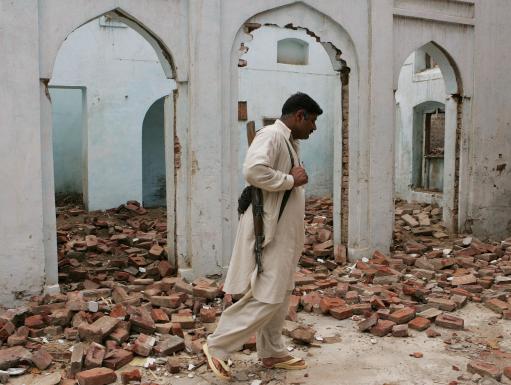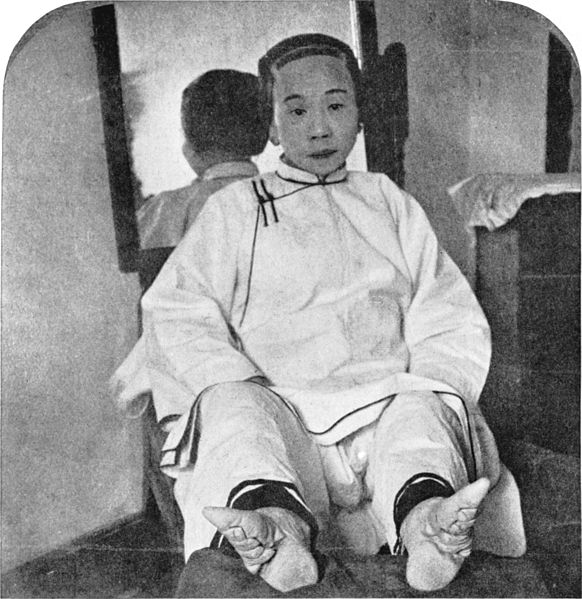
After emerging from the long tunnel of time in the aftermath of the First World War, Arab Muslim societies now find themselves standing before two contradictory phases: the awakening of death and the struggle for life. How this dynamic struggle resolves itself will determine the future of these societies as they continue to labour under cultural stagnation as a result of colossal intellectual restrictions.
ONE ANCIENT CHINESE custom that arose in the tenth century towards the end of the Tang Dynasty was the binding of young girls’ feet with long strips of material so as to restrict their growth to a mere seven centimetres. Standards of beauty of the time viewed the natural size of a woman’s foot as something aesthetically undesirable. Despite the fact that this harsh and inhumane procedure caused many health problems from the crushing of bones in the feet due to the inhibition of growth, this social custom remained in force in remote areas of China right up to the time of the Communist revolution. Iron shoes were also used to inhibit the foot’s growth. These shoes were decorated in order to appeal to children. In December 1997 the first academic study on the side-effects of foot-binding were published by the University of California (San Francisco – UCSF).[1] Its most important finding indicated the permanent, chronic crippling of the victims of this technique, with many aged Chinese women continuing to suffer from its effects.
The foot is a natural part of the human body with a recognised biological function. Strangling the growth of a biological organ leads to the permanent impairment of its function. Seen from another angle, the biological organs are the result of a natural development that provided the living organism with the ability to confront natural challenges in its struggle for survival. The greater mastery the organism displays in the employment of the foot, the greater is its chance of survival in the face of its natural enemies.
The human brain is the most complex organ in the evolutionary chain and it is one that bestows upon the human being a tremendous capacity to confront challenge. For this reason cultures arose and developed in all its aspects for the protection of the human species as individuals and groups. The more mankind developed his intellectual potential, the more he increased in strength and capacity to challenge. The creativity of the human brain can be seen at work in the phenomenon of social accumulation, whereby accumulating and developing skills become passed from one generation to another. August Comte’s three-stage paradigm for the development of human thought demonstrates the ability of the mind to understand nature through successive phases of development – with the addition of what I would claim to be a fourth phase in the form of a phase of exploitation of science in the service of humankind and human society as it confronts its various challenges.[2]
Iron chains have led to a permanent intellectual crippling
Just as the Chinese bound the feet of young girls in order to constrict their growth, Islamic thinkers have, from the 10th century until now, undertaken to bind back thought and prevent the human brain from properly performing its function.[3] The chronic intellectual impairment resulting from these iron chains can be seen in the social and cultural backwardness that has dogged these societies over the last centuries, and indeed still dogs them up to the present-day. It has led to the suspension of scientific achievement – which arises basically to meet the challenges of nature – and accordingly scientific accumulation has fallen away for the simple fact that it was entirely absent.[4] These iron chains have thus lead to a permanent intellectual crippling. The enduring centuries-long impairment that has resulted from these intellectual restrictions accounts for the present incapacity of Arab Muslim societies to meet all the various forms of challenge that confront them.
After emerging from the long tunnel of time in the aftermath of the First World War, these Arab Muslim societies now find themselves standing before two contradictory phases: the awakening of death and the struggle for life. How this dynamic struggle resolves itself will determine the future of these societies as they continue to labour under cultural stagnation as a result of colossal intellectual restrictions. These restrictions are characterised by an immense millennium-long accumulation of backwardness with all its effects on society, effects which individuals are still unable to break free of. The struggle for life can be seen in the attempts made by these societies to keep up with contemporary human civilisation and seek the foothold they have been deprived of for many centuries.
It is a struggle fought with hobbled intellectual capacities
How these forces are wrestled with determines the nature of a society’s dynamism. The present struggle is not one that is being waged for construction and renaissance; rather it is a struggle for life and for confronting challenges, and one that is being fought with hobbled intellectual capacities. It is either a question of returning to the cultural stagnation that existed prior to the First World War, or it is a leap forward towards what is a mere dream of renaissance rather than an actual renaissance in itself. For these societies are still far removed from any such renaissance; exhaustion and cultural fatigue has brought these societies to a point where they are simply unable to make the distinction, so they are heading sooner or later towards social suicide. For there is no doubt that social phenomena such as:
- legitimised terrorism in its various forms
- the frequency of revolutions, uprisings and reforms within a short space of time
- practices which abolish collective awareness and education due to their alienation from reality and their undervaluing of science and scientific thought
- continuous destruction of infrastructure (however small and rudimentary that already is), and of organisations under various guises
- religious and sectarian rivalry, attempts at settling scores and the continuous destruction of ideas of citizens that might be conducive to a single society
- killing and destruction carried out under the cloak of principles and higher ideals
- moral and ethical collapse
- global destruction of culture and heritage (the destruction of the self)
- indifference to the tremendous material and economic losses incurred as a cause of the above,
– are but evidence of unnatural social phenomena (social suicide).
The issue of societal suicide may not be something one comes across frequently in sociology because it is rare, as indeed there is a lack of familiarity with ironclad intellectual restriction. Perhaps Arnold Toynbee was the first to deal with the concept of societal suicide in his theory on the collapse or death of societies.[5] With regard to Islamic societies, the first to give a historical analysis in his treatment of this tragedy in Islamic thought, and to use the term ‘intellectual suicide’, was the scholar Robert Reilly.[6] Reilly dealt with the subject from the angle of intellectual isolation and thus put forward the concept of ‘cultural suicide’. But when dealing with society as an interactive, dynamic construct, it is our view that cultural suicide leads to societal suicide – and this is indeed what is happening.
They are heading sooner or later towards social suicide
There are those who ascribe this collapse to foreign interventions, yet over the course of history human societies have, in one way or another, interacted. The capacity to face intervention calls forth the capacity to confront challenge, and this is one of the reasons behind the development of a civilisation, as Toynbee sees it.[7] Attempts at intervention constitute a natural phenomenon, while the incapacity to confront this only spells weakness and impotence. These communities are not weak in themselves but their centuries-long intellectual isolation has robbed them of the ability to develop and face up to challenge. This constitutes their mortal weakness.
Failed societies may possess a capacity for material construction, but they nevertheless lack the human potential and the societal awareness necessary for this capacity. Such societies either fail in their attempts to build when relying on their own abilities, and simply build and demolish, or they resort to adopting a borrowed human potential. The first model, one that results in continuous building and demolition, always ends up sliding into reverse gear, while the second model lacks what is required to continue the process of construction– it therefore easily falls into disrepair when the borrowed forces withdraw from the building process.
Everything that has been spent since the beginning of the 20th century until now in developing these societies has either, in part or in total, gone to the four winds. And what remains is fast on its way out too. The basic problem of these societies is their inability to reconstruct the individual so that he can rebuild contemporary society. Modern challenges are now becoming too big for a centuries-long restricted mindset to accommodate.
[1] Cummings SR, Xu L, Stone K 1997 ‘Consequences of foot binding among older women in Beijing, China’. Am J Public Health 87:1677–1679.
[2] Sanduk M., ‘Is the Technology a New Way of Thinking?’, The Journal of Technology Studies, Volume XXXVIII, Number 2, 2012.
[3] Reilly R, The Closing of the Muslim Mind: How Intellectual Suicide Created the Modern Islamist Crisis, Intercollegiate Studies Institute; 1st Edition (April 4, 2011).
[4] Sanduk M, Growth of science under the influence in Arabic-Islamic and Western Civilisations, 700-1900 (Statistical Models), Pittsburgh University, Philosophy of science archive, 2012. http://philsci-archive.pitt.edu/9012/ .
[5] Arnold J. Toynbee, A Study of History, Oxford University Press (1947). p. 273.
[6] R. Reilly, op.cit.
[7] Arnold J. Toynbee, op cit.




